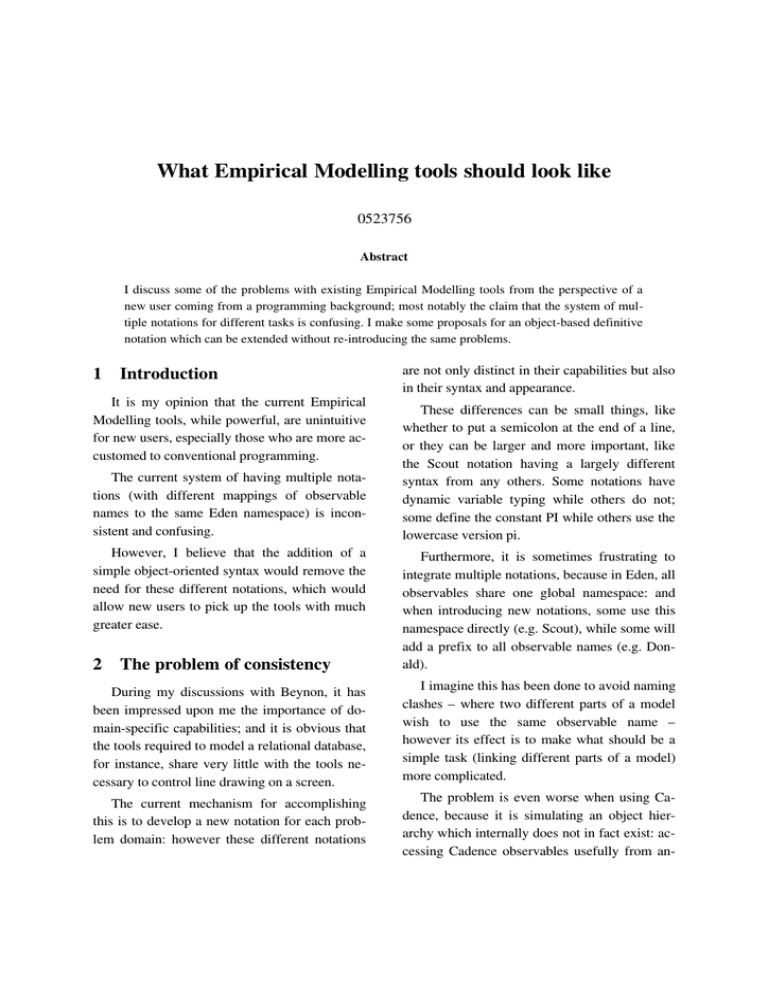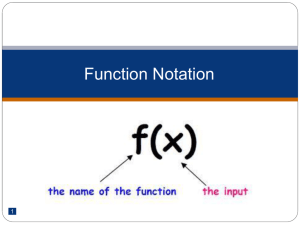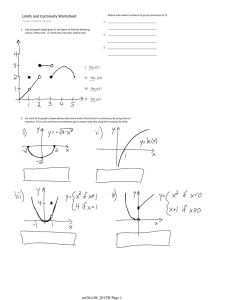What Empirical Modelling tools should look like 0523756
advertisement

What Empirical Modelling tools should look like
0523756
Abstract
I discuss some of the problems with existing Empirical Modelling tools from the perspective of a new user coming from a programming background; most notably the claim that the system of mul­
tiple notations for different tasks is confusing. I make some proposals for an object­based definitive notation which can be extended without re­introducing the same problems.
1 Introduction
It is my opinion that the current Empirical Modelling tools, while powerful, are unintuitive for new users, especially those who are more ac­
customed to conventional programming.
The current system of having multiple nota­
tions (with different mappings of observable names to the same Eden namespace) is incon­
sistent and confusing.
However, I believe that the addition of a simple object­oriented syntax would remove the need for these different notations, which would allow new users to pick up the tools with much greater ease.
are not only distinct in their capabilities but also in their syntax and appearance.
These differences can be small things, like whether to put a semicolon at the end of a line, or they can be larger and more important, like the Scout notation having a largely different syntax from any others. Some notations have dynamic variable typing while others do not; some define the constant PI while others use the lowercase version pi.
2 The problem of consistency
Furthermore, it is sometimes frustrating to integrate multiple notations, because in Eden, all observables share one global namespace: and when introducing new notations, some use this namespace directly (e.g. Scout), while some will add a prefix to all observable names (e.g. Don­
ald).
During my discussions with Beynon, it has been impressed upon me the importance of do­
main­specific capabilities; and it is obvious that the tools required to model a relational database, for instance, share very little with the tools ne­
cessary to control line drawing on a screen.
I imagine this has been done to avoid naming clashes – where two different parts of a model wish to use the same observable name – however its effect is to make what should be a simple task (linking different parts of a model) more complicated.
The current mechanism for accomplishing this is to develop a new notation for each prob­
lem domain: however these different notations The problem is even worse when using Ca­
dence, because it is simulating an object hier­
archy which internally does not in fact exist: ac­
cessing Cadence observables usefully from an­
other notation is convoluted to the point of in­
feasibility.
fact no reason they must be strings, or meaning­
ful at all.
This might be acceptable if everything could be easily done from within Cadence, but since the system of having multiple notations man­
dates a change of notation to access additional functionality like line drawing, this extra func­
tionality cannot be used to its full effect together with Cadence.
This in contrast to strongly typed languages such as Java or in C++, where given an object's type you know exactly what properties it has (and these cannot change), which is unlikely to be a good fit with the Empirical Modelling paradigm. Instead, an object should be able to have any property defined or redefined at any time, and the context in which you use an object determines the properties which are examined.
3 One notation for everything
My proposed alternative is to have just one consistent notation, which would be flexible and extensible enough to model different systems without modifying the core language.
It should be noted that all the existing nota­
tions at some level map down to Eden defini­
tions: they simply add syntactic sugar and addi­
tional functionality at the same time. So how can we have this level of extensibility while retain­
ing a common syntax?
I believe the answer is to have a built­in ob­
ject data type. Objects are an intuitive way of grouping sets of observables that are logically connected in some way, and this is something that is sorely lacking in Eden at the moment.
The real strength of having an object data type is their flexibility. They can represent any data structure and so are well­suited to the idea of a consistent notation.
There are current prototypes to extend Eden to introduce this functionality (Cadence) and to implement dependencies on top of an object­
based framework (Doste), but each of these ap­
proaches has their own advantages and disad­
vantages.
An object in the sense I discuss here (and as implemented in those notations) is nothing more than a mapping of key­value pairs, where the value can itself be another object. The keys may be thought of as property names, but there is in This is commonly known as duck­typing, after the so­called duck test:
“If it looks like a duck and quacks like a duck, it is probably a duck.”
For example, if you consider a point to be something with an x and a y coordinate, then any object with an x and a y property (which would have to be numbers?) can be treated as a point.
It should be made clear that the introduction of objects does not replace definitive notations, but rather makes them more flexible. Even if used for nothing else, the ability to create hier­
archical structures (which also mitigates against naming clashes) would make current definitive scripts more structured and more readable.
4 Operators and functions
Functions are a tremendously useful feature to have, and I believe that a notable part of my annoyance at the multiple notation system is the fact that they can only be defined in Eden and only used in a subset of notations.
The ability for the result of a function to be assigned by dependency (so that it is updated when a parameter is modified) makes them es­
pecially powerful.
Operators are even more important, because they are functions in a more intuitive and con­
venient form: a+b is essentially just add(a,b).
In some languages it is possible to redefine the basic operators to behave differently in cer­
tain situations, and I believe this may be neces­
sary to compete with the expressive power of the multiple notation system.
is the result if you attempt to add an object to an integer?
The ability for custom operators alone to re­
place specialised notations is suggested in a tiny way in my database.example file, which at­
tempts to demonstrate how small syntax changes are all that might be required to convert an Eddi script to a hypothetical unified notation.
These will have to be considered and care­
fully prototyped. Probably it will take much ex­
perimentation to discover the best approach here.
It is also a concept which I feel fits very well with the “what would happen if I...” approach to experimenting with a model.
However, care needs to be taken to avoid confusion over what will happen for any given calculation: if the operation you define is unintu­
itive, the situation may be no better than cur­
rently it is with inconsistent notations.
There are many open questions in this area, which I unfortunately have no answers to at present:
What happens if two different things try to extend the same operator?
How do you ensure that a given set of operat­
ors are consistent with expectations?
Could there be different sets of operators, of which only one would be active at a time? My instinct that this is too close to having multiple definitions, but I mention the idea for the sake of completeness.
Is it best to attempt to create a generalised al­
gebra which will work for arbitrary objects? For example, the addition operator applied to two objects could add each attribute separately: for example {a = 5, b = 5} + {b = 5, c = 5}
would equal {a = 5, b = 10, c = 5}. This would certainly give correct results for points (just an x and a y attribute), but would it in gen­
erally be intuitive, and can a full complement of these generic operations be designed? And what Should the user be allowed to (re)define their own operators, or should they be built­in at a higher level?
5 A drawing hierarchy
A line can be considered a set of two points, and a point can be considered to be an x and a y coordinate.
It is tremendously intuitive to be able to con­
sider these properties directly. Currently this is possible from Donald but less intuitive in Eden: an object­based syntax would make it If we further suppose every drawable object can (but does not have to) contain a property “children”, which itself contains other drawable objects, then these child objects could be drawn relative to their parent. Then moving or rotating the parent would also move the children.
This would allow groups of drawable objects to be transformed together: a task which I find very useful in conventional graphics program­
ming.
This functionality has been prototyped by Nick Pope and Sam Gynn in Doste using the Warwick Game Design library, although their work focused on UI widgets rather than general­
ised line drawing.
A further (non­working) example can be found in my drawing.example file written in a hypothetical object­based definitive notation.
6 Implementation
It is my hope that this is not just an idealistic theory, but rather a practical solution to many of the problems that the Empirical Modelling tools currently pose. For it to be useful, however, it must be implemented and then functionality ad­
ded to bring it up to the capabilities of the cur­
rent system.
There are currently two object­based definit­
ive notations which could serve as a basis for this work. 6.1 Doste
Most of what I discuss here either exists already in Doste or could be built on top of it in­
stead.
However, more work would have to be done in the area of extending the language to support the same diversity of models as is currently pos­
sible in Eden.
6.2 Cadence
The current implementation of Cadence is a feasible platform for these ideas. I have attemp­
ted to construct several models using it but there is a constant need to revert back to Eden to do anything. For example it is necessary to use the Eden notation to define functions, and the Don­
ald notation to draw to the screen.
However I am informed that an implementa­
tion not based on Eden is under development, so those problems should not be relevant when that is complete.
Acknowledgements
Many thanks to Meurig Beynon for his work in shaping this paper and explaining his per­
spective on the various topics I discuss.
Also I would like to thank Nick Pope for his work on Doste and for introducing me to it through the Warwick Game Design library.




